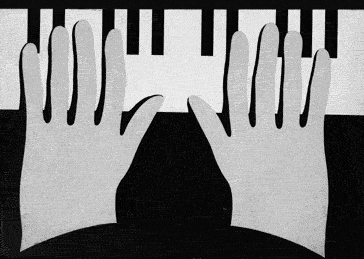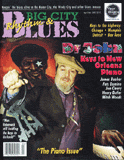
Red Light District
Storyville:
Birthplace of New Orleans piano sound
By Michael Richardson
The century old history of the distinctive
New Orleans piano sound, a rolling, rollicking, incessant party rythym,
begins in the brothels of Storyville in the late 1800's and grew out of
ragtime styling.
Storyville, located at the edge of the
French Quarter, was the nation's most infamous red light district for
20 years, In 1897 Sidney Story was able to persuade his colleagues on
the City Council to approve prostitution in a regulated area which soon
became nicknamed Storyville. Legalized prostitution was the main business
of Storyville from January 1, 1898 to November 12, 1917.
Before the advent of recorded music many
of the brothels featured pianos to entertain the patrons. While the prostitutes
turned up the heat in the backrooms the piano player would keep things
hot in the parlor. Often the pianos in the houses of ill repute would
be out of tune and not infrequently in disrepair. To compensate for sticky
keys, dead strings, and off-note sounds the piano players would pound
at several keys instead of just one. They developed their own techniques
that included using a fist, the side of the hand, and just about anything
that would get the sound out of the battered pianos.
Many, if not most, of the Storyville piano
players plied their trade in anonminity, never recording, never marqued,
and generally under appreciated. Names like Willie Drive 'Em Down Hall,
Sullivan Rock, Kid Stormy Weather, and Tuts Washington never made it out
of New Orleans. The first Storyville musician to make it big ended up
leaving the Crescent City, touring, and ultimately moving to New York.
Jelly Roll Morton 1890-1941
Ferdinand Joseph Lemott, was born October
20, 1890 in New Orleans. As a child Lemott explored a number of instruments
before settling down with piano at age ten. As a young teenager Lemott
began playing in the Storyville brothels developing his own transition
from ragtime to jazz. By 1904 the future Jelly Roll Morton had left New
Orleans and began travelling the South playing music, doing vaudeville
comedy, gambling, and reportedly pimping.
Jelly Roll settled in the Los Angeles
area in 1917-1922 and then headed to the Windy City until 1928 when he
left Chicago for New York where he lived until 194O. Morton then moved
back to Los Angeles where he died July 10th at age 50. Following his death
Jell Roll Morton developed a strong following with the revivial of interest
in New Orleans jazz, which always remained his distinctive sound.
One of the first great jazz composers,
Morton wrote a number of classics including early blues songs taking rural
Delta folk music and infusing it with his own bouncy piano sound. Songs
such as "Mr. Jelly Roll," "Wolverine Blues," "Black
Bottom Stomp," "Wild Man Blues," King Porter Stomp,"
"Sidewalk Blues," "Dead Man Blues," "Jungle Blues,"
"West End Blues," Cannon Ball Blues," and many others rolled
from his pen.
Some of the fame due Jelly Roll Morton
was diluted upon his death after an unfortunate publicity flap cast him
as competing with W. C. Handy as the originator of jazz. At one point
Jelly Roll purportedly made the claim he "invented" jazz in
1902 back in Storyville.
Champion Jack Dupree 1910-1992
William Thomas Dupree was born on the
4th of July, 1910 in New Orleans. While still an infant Dupree's parents
were both killed when the family home burned. Although the blaze was labelled
accidental Dupree would sometimes claim the blaze had been set by the
Klu Klux Klan. In any event the young orphan was sent to the Colored Waifs
Home for Boys, the same orphanage that Louis Armstrong was raised in.
Dupree began playing piano at the orphanage
taught by an Italian priest. At age fourteen Dupree traded institutional
routine for a life on the streets. Willie Hall then taught the teenager
all about boogie piano and the Storyville venues offered the work. During
this period of street hustling Dupree took up boxing at a gym on Rampart
Street.
By age 20 Dupree was tired of the racism
of the South and moved to Chicago, then Detroit, ending up in Indianapolis.
While in Detroit, Dupree met Joe Louis and boxing seemed to offer a way
up and out. Dupree won a lightweight championship bout in Indiana in 1935
and ended his boxing career with 107 fights to his name--which by now
had changed to Champion Jack Dupree.
In 1940 Champion Jack returned to the
keyboard where he would pound out the tunes and started recording for
the Okeh label but World War II interrupted those plans. Life seemed safe
enough as a cook in the Navy but out on the front Champion Jack got captured
and spend two years as a POW of the Japanese.
Dupree moved to New York following the
war and recorded under several different names for 21 different labels.
The only song that Champion Jack recorded that made the charts was in
1955, a duet with Teddy McRae called "Walking the Blues." In
1958 Dupree released "Blues From The Gutter," a release that
many consider his finest work and seemed to be a reprise of his early
life in Storyville.
Continuing to be dissatisfied with life
in segregated America, Dupree moved to Europe in 1959 where he lived until
his death January 21, 1992. After a 36 year absence Champion Jack returned
to New Orleans in 1990 for the Jazz and Heritage Festival and recorded
"Back Home in New Orleans" backed by an all-star line-up of
Crescent City musicians. Contemporary musician Billy Diamond says, "Champion
Jack started it all, Professor Longhair, James Booker, Fats Domino, they
all followed him, he was first."
Professor Longhair 1918-1980
Henry Roeland Byrd was born December 19,
1918 in Bogalusa, Louisiana but raised in New Orleans. By then Storyville
was no longer wide open but music venues still abounded in the French
Quarter. Byrd's first gig was tap dancing for tips on Bourbon Street learning
piano, guitar and drums along the way. Legend has it that Byrd's first
piano was an old junker retrieved from the trash. In the early 1930's
Byrd was in and out of various bands. He left music to pursue cooking,
boxing, and card playing. Eventually World War II gave Byrd a stint in
the Army. Music again beckoned and by 1948 Professor Longhair and the
Four Hairs were on stage. That band was followed by Professor Longhair
and his Shuffling Hungarians with who he recorded in 1949. In 1950 his
new band called Roy Byrd &The Blues Jumpers released "Bald Head",
the only release the Professor had that hit on the R&B charts.
Professor Longhair acquired his name in
1948 when Caldonia Club owner Mike Tessitore introduced him as such commenting
on his shaggy hairstyle. Longhair built upon the existing New Orleans
sound by mixing in a little Latin spice with a Caribbean taste. The song
"Tipitina" was the inspiration that led to the growth of the
New Orleans music club chain. "Going to Mardi Gras" is a virtual
anthem in the Crescent City. Longhair's happy music mixed in mambo-rhumba-boogie
riffs with everything else and added his own unique signature to the New
Orleans piano sound.
Although Professor Longhair is legendary
and highly revered in New Orleans he is not well known outside of Louisiana
and didn't pay much attention to what the rest of the world thought or
was up to. By the 1960's "Fess" had returned to card playing
and was also doing custodial work to support himself. Fortunately the
slump did not last and in 1971 Longhair made a comeback launching his
recharged career at the Jazz & Heritage Festival which he continued
to perform at until his death. Longhair traveled to Europe in 1973 and
played at the Montreux Jazz Festival. He would get featured on the PBS-TV
concert show Soundstage and make a documentary about piano players that
ultimately became a memorial video as Longhair died before it was finished.
Professor Longhair died on January 30,
1980 in his sleep. Longhair's last release "Crawfish Fiesta"
came out on the day he died.
Back
to Top
Back
to Contents Page
 A cure for the blues
A cure for the blues
six times a year.
|

Cover photo by
Robert Jr Whitall
March 2, 2003 on Fat Sunday at the House of Blues, New Orleans
|